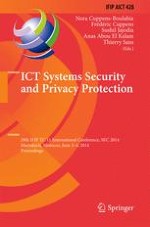2014 | Book
ICT Systems Security and Privacy Protection
29th IFIP TC 11 International Conference, SEC 2014, Marrakech, Morocco, June 2-4, 2014. Proceedings
Editors: Nora Cuppens-Boulahia, Frédéric Cuppens, Sushil Jajodia, Anas Abou El Kalam, Thierry Sans
Publisher: Springer Berlin Heidelberg
Book Series : IFIP Advances in Information and Communication Technology
